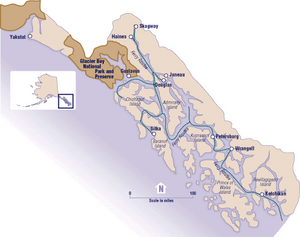Inside Passage facts for kids
The Inside Passage (which means "Inner Passage" in French) is like a secret watery highway for ships and boats. It's a network of channels and passages that wind through islands along the coast of North America. This amazing route stretches from southeastern Alaska in the United States, goes through western British Columbia in Canada, and ends in northwestern Washington state in the United States.
Ships use the Inside Passage to avoid the rough weather of the open ocean. It also lets them visit many small, isolated towns and communities along the way. Lots of different boats travel here, including big cruise ships, cargo ships, tugboats pulling things, fishing boats, and even small pleasure boats. Ferries like the Alaska Marine Highway, BC Ferries, and Washington State Ferries also use this route. Even the Coast Guard from both Canada and the U.S. patrols these waters.
Sometimes, when people say "Inside Passage," they are also talking about all the ocean and islands around this special route.
Contents
Where is the Inside Passage?
The Inside Passage generally starts in Olympia, Washington, which is at the very bottom of Puget Sound. As you travel north, the route goes into the larger Salish Sea. It then passes through the Strait of Georgia and Johnstone Strait, which are between Vancouver Island and the mainland of British Columbia.
From there, it continues northwest into the Alaska Panhandle. The very northernmost points of the Passage are the towns of Haines and Skagway, located at the end of the Lynn Canal. Navigating the Inside Passage can be tricky because of changing weather, big tides, strong currents, and not many safe places to anchor.
Long ago, during the Klondike Gold Rush, this passage was one of the main sea routes for American gold seekers traveling north from Seattle and California.
Today, about 36,000 recreational boats use parts of the Inside Passage for fun trips. The Marine Exchange of Alaska is a group that tracks and follows all the ship traffic in the Alaskan part of the Passage.
Washington's Waterways
The part of the Inside Passage in Washington state is mostly made up of the waterways of Puget Sound. It begins in Budd Inlet near Olympia and then widens into the Nisqually Reach. The route continues northeast, passing through the Tacoma Narrows, and then heads north towards the San Juan Islands, which are close to the Canadian border.
British Columbia's Channels
British Columbia's section of the route includes the narrow, protected Strait of Georgia between Vancouver Island and the mainland. It also features the Johnstone Strait and Discovery Passage. Further north, the route is protected from big Pacific waves by large islands like Princess Royal Island and Pitt Island. This part includes many channels and straits, such as Fisher Channel, Lama Passage, Seaforth Channel, Milbanke Sound, Finlayson Channel, Sarah Passage, Tolmie Channel, Princess Royal Channel, McKay Reach, Wright Sound, Grenville Channel, Arthur Passage, and Chatham Sound.
Alaska's Islands
Alaska's part of the Inside Passage stretches about 500 miles (800 km) from north to south and 100 miles (160 km) from east to west. This huge area has about 1,000 islands and thousands of small coves and bays. While the Alexander Archipelago in Alaska helps protect the area from the rough Pacific Ocean weather, much of the region experiences strong tides that change twice a day. The Lynn Canal is the northernmost waterway of the Inside Passage.
Fun Things to Do in the Inside Passage
The Inside Passage is a very popular place for tourists. The coastal mountains and islands offer amazing chances to see wildlife and enjoy activities like boating, fishing, kayaking, camping, and hiking. You can watch birds, go whale watching, or even see bears! There are special places to watch bears at Anan Creek near Wrangell and at Pack Creek Bear Sanctuary on Admiralty Island near Juneau.
The most popular way to explore the Inside Passage in summer is by cruise ship. Over 2 million people take cruises here each year, which really helps the local economy. Many big cruise lines offer trips through the Inside Passage, including Norwegian, Disney, Princess, Celebrity, and Cunard. Most of these cruises start and end in Vancouver or Seattle.
There are also smaller expedition cruises that explore the Inside Passage. These ships are usually smaller than the main cruise lines and focus more on watching wildlife. For example, National Geographic operates several expedition boats here.
A Brief Look at the 1994 Transit Fee Issue
In 1994, during talks about salmon fishing, Canada felt that the United States wasn't listening to its concerns. So, on June 15, 1994, Canada started charging a fee to all U.S. commercial fishing boats that used the Canadian part of the Inside Passage. This fee was later removed after both countries talked things over.
In response to Canada's action, the U.S. Congress passed a law on October 24, 1995. This law allowed the U.S. government to pay back American fishers for any fines or costs they had because of being stopped by foreign governments. Luckily, this situation remained peaceful, and there were no violent events between U.S. fishing boats and Canadian officials.
Images for kids
See also
 In Spanish: Pasaje Interior para niños
In Spanish: Pasaje Interior para niños




